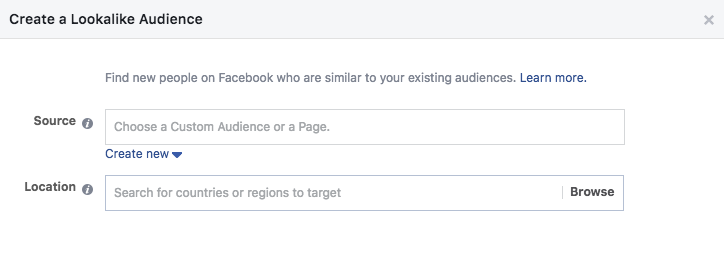3 Tips to Building Good Lookalike Audiences in Facebook

As advertisers we know Facebook can be great for reaching out to cold audiences, but we also know costs can get high and return low if we don’t get our targets right.
One of the very first things one should do when trying to reach cold audiences is to build lookalike audiences and target them before passing budget onto to other target audiences. Lookalikes can often be very cost effective in relation to other audience targets and let us use the machine learning power of Facebook to our benefit.
Let’s briefly define lookalikes before we dive into 3 ways you can refine your lookalikes to get the best performance.
A lookalike audience is an audience that “looks like” a source audience on which it is based. So, if you have a customer list of prior purchasers of your product, creating a lookalike would be finding people who resemble that audience. With the ultimate goal that this new lookalike audience would be new people who are likely to purchase as well. This type of targeting can be a core strategy in any cold audience targeting campaign.
Let’s now figure out how best to create these audiences for the best chance at good performance.
Build Your Lookalike on Your Most Down Funnel Activity

In order to build a lookalike audience, you first need to create a source audience in which to base it on. This source audience can be created in all sorts of different ways using site visitors to video viewers to purchasers and leads.
The key is that whatever you put in this source audience is what the Facebook algorithm is going to model the lookalike after. So, if you want to go after people likely to purchase, but your source audience is based on site visitors, then the lookalike is going to be filled with people who are likely to visit your site. Not necessarily those who are likely to purchase. While you would likely see purchasers, it would be much less efficient from a CPA or ROI perspective.
How do you pick the right source audience?
First, figure out what the core metric you want drive is (leads, purchases, traffic, engagement, etc.) and create an audience based on that activity. You can use pixel activity or a customer file upload to create this audience. If a particular geolocation is important to this target, make sure your source audience includes only people from that geolocation. Otherwise you’ll likely get an audience that is spread across an entire region and very few in your specific geolocation.
Stay Within 1-2% for Best Results

Once you’ve created a proper source audience, the next decision is how big your lookalike audience will be. This is determined by a slider with a percentage attached to it (ranging from 1% to 10%). The higher the percentage the less like the source audience your lookalike audience will be and less likely to drive your intended action.
If you are trying to drive a very specific conversion, it’s best to stick to the 1-2% range as it will create a lookalike that most resembles the source audience and is most likely to drive your desired action.
When running conversion campaigns, we’ve seen CPA climb pretty high once you get to the 3% mark and get very high beyond 5%. Tuning the percentage of your audience should also be dictated on your desired outcome. If you want to drive traffic and engagement you might be able to use a 4-5% audience, but if efficiency is important you’ll want to start at the 1-2% range.
Very Rarely Should You Have to Filter it at the Ad Set Level
Now that you’ve created the proper source audience and chosen your lookalike audience size, be very careful about filtering it with extra audience variables at the ad set level.
If you followed the above steps, the lookalike audience should already include audience targeting variables you might want. That’s the job of Facebook’s machine learning and lookalike modeling. By adding filters, you might be unnecessarily hurting performance.
The one occasion that you are warranted in adding a filter is when restricting to a geotarget is important. Often a lookalike, even when properly built, will still capture some people outside a specific geotarget. Adding one is just a good safety measure to make sure you’re getting the right people.
If performance isn’t there and the lookalike is performing poorly, you can attempt to add filters as a last-ditch effort to hit goals, but you might be better reworking your source audience and trying again.
Conclusion
Lookalikes can be a great way to go after cold audiences in Facebook when built and used correctly. Take the above tips and see how they might help improve your performance.



